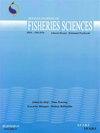里海东南部地区里海海豹的季节分布和一些生物学参数
IF 0.6
4区 农林科学
Q3 FISHERIES
引用次数: 3
摘要
里海海豹(Pusa caspica)是唯一一种生活在里海内陆的哺乳动物。这项研究是2010年至2016年在里海东南部地区对里海海豹进行的首次此类研究。对每只观测到的里海海豹的季节观测、性别、成熟度、生物特征参数和状态指数进行了研究。本研究共观察到74只活里海海豹,其中雄海豹42只,雌海豹32只。秋季观测到的里海海豹数量显著多于其他季节(p 0.05),但幼海豹数量显著多于成年海豹(p 0.05)。成海豹和幼海豹的生物特征参数差异有统计学意义(p < 0.05)。由于里海海豹被列为世界自然保护联盟红色名录中的濒危物种,因此需要进一步研究以了解该种群的状况并保护里海唯一的哺乳动物。本文章由计算机程序翻译,如有差异,请以英文原文为准。
Seasonal distribution and some biological parameters of the Caspian seal (Pusa caspica) in the southeastern region of the Caspian Sea
The Caspian seal (Pusa caspica) from Phocidae family is the only living mammal that exclusively inhabits the landlocked Caspian Sea. This study was first of its kind conducted on the Caspian seals in the southeastern region of the Caspian Sea from 2010 to 2016. Seasonal observations, gender, maturity, biometric parameters and condition index of each observed Caspian seal were studied. Totally 74 live Caspian seals including 42 males and 32 females were observed in this study. The Caspian seals observed in autumn were significantly greater in number than in the other seasons (p 0.05), however, the number of juvenile seals were significantly more than adults (p 0.05). A significant difference was observed between adult and juvenile seals in biometric parameters (p 0.05). Since Caspian seals are listed as endangered species in the IUCN Red List, further research is required to understand the status of this population and conserve the only mammals of the Caspian Sea.
求助全文
通过发布文献求助,成功后即可免费获取论文全文。
去求助
来源期刊

Iranian Journal of Fisheries Sciences
FISHERIES-
CiteScore
2.30
自引率
11.10%
发文量
0
审稿时长
3 months
期刊介绍:
1- Living various species (contains animals and vegetal species) in various aquatic ecosystems.
2- Health and diseases of aquatic species.
3- Determining the stocks and specific time and location for catching and reliable exploitation for sustainable development.
4- Methods of propagation and culture of high value aquatic resources.
5- Aquatic stock assessment and the methods of restocking the high value species and suggestion for rate, areas and the time for releasing fish and other aquatic organisms fries.
6- Pollutant agents and their effects to the environments of aquatic species.
7- Feed and feeding in aquatic organisms.
8- Fish processing and producing new products.
9- The economic and social aspects of fisheries.
 求助内容:
求助内容: 应助结果提醒方式:
应助结果提醒方式:


